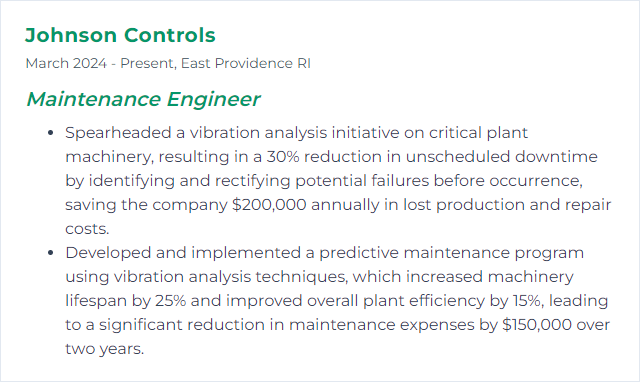Top 12 Maintenance Engineer Skills to Put on Your Resume
A sharp, well-aimed resume that spotlights Maintenance Engineer skills cuts through the noise. Blend hands-on technical depth with crisp troubleshooting, smart systems thinking, and clear communication. That mix signals you keep machines humming and downtime on a short leash.
Maintenance Engineer Skills
- PLC Programming
- HVAC Systems
- AutoCAD
- Electrical Troubleshooting
- Preventive Maintenance
- Hydraulic Systems
- Pneumatic Systems
- Welding Techniques
- SCADA Systems
- Mechanical Design
- Robotics Integration
- Vibration Analysis
1. PLC Programming
PLC programming means building and refining the logic that drives automated equipment. You write, test, and tune control code (ladder, function block, structured text) so lines run safely, consistently, and fast.
Why It's Important
When a process stutters, strong PLC skills turn chaos into order. You diagnose quickly, modify safely, and get production back online with minimal fuss and fewer surprises.
How to Improve PLC Programming Skills
Anchor yourself in IEC 61131-3 concepts: data types, scan cycles, tasks, and program structure.
Practice on vendor toolchains (e.g., TIA Portal, Studio 5000, Codesys). Simulate first, deploy second.
Adopt clean-code habits: readable tags, clear comments, version control, and change logs.
Design for diagnostics: latched fault bits, timestamped events, and structured alarms.
Standardize function blocks for repeatable machines; build libraries and reuse with intent.
Prioritize safety: interlocks, permissives, fault handling, and proper startup/shutdown sequences.
Review with operations and maintenance—close the loop and refine what really matters on the floor.
How to Display PLC Programming Skills on Your Resume

2. HVAC Systems
HVAC covers heating, ventilation, and air conditioning—systems that tame indoor temperature, humidity, and air quality. For maintenance, that means inspections, cleaning, tuning, and timely repairs so occupants stay comfortable and energy bills don’t spiral.
Why It's Important
Healthy air and steady temperatures keep people productive and equipment happy. Efficient HVAC trims energy spend and prevents costly outages, especially during peak seasons.
How to Improve HVAC Systems Skills
Build a seasonal PM schedule: filter changes, belts, bearings, coils, drains, sensors, and ducts.
Dial in airflow: balance dampers, verify static pressure, and eliminate choke points.
Seal and insulate: stop leakage, protect ductwork, and maintain thermal integrity.
Tune controls: use occupancy schedules, setpoint deadbands, and demand-limiting strategies.
Track refrigerant management and compliance; choose low-GWP alternatives where feasible.
Run energy audits and retro-commission systems; fix what the data reveals, not guesses.
How to Display HVAC Systems Skills on Your Resume

3. AutoCAD
AutoCAD is a CAD workhorse for crisp 2D drawings and solid 3D models. Maintenance engineers use it to map plant layouts, mark utilities, detail retrofits, and communicate changes without ambiguity.
Why It's Important
Clear drawings prevent missteps. With accurate plans, you plan access, route services, and stage shutdowns with fewer surprises and safer outcomes.
How to Improve AutoCAD Skills
Master shortcuts and aliases; shave minutes from every task and hours from every project.
Build templates, title blocks, and standards for layers, linetypes, and plotting.
Use blocks, dynamic blocks, and parametrics to keep designs adaptable and tidy.
Extract data for BOMs, tag lists, and maintenance inventories—let drawings feed your CMMS.
Customize workspaces and palettes for your maintenance workflows.
Keep up with new releases; adopt features that remove drudgery or reduce errors.
How to Display AutoCAD Skills on Your Resume
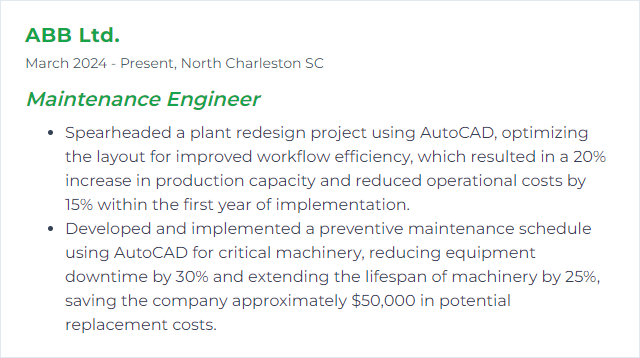
4. Electrical Troubleshooting
Electrical troubleshooting hunts down faults in circuits and equipment. You trace symptoms to causes—then fix, verify, and document so the issue stays fixed.
Why It's Important
Fast, safe fault-finding keeps production stable and people safe. Every minute saved on diagnostics is a minute given back to throughput.
How to Improve Electrical Troubleshooting Skills
Nail the fundamentals: Ohm’s law, power, three-phase systems, grounding, and protection.
Lead with safety: lockout/tagout, arc-flash boundaries, PPE, and energized work rules.
Use the right instruments: DMMs, clamp meters, insulation testers, scopes, and thermal imaging.
Read schematics like a map; confirm against as-built drawings and mark corrections.
Be systematic: isolate, hypothesize, test, confirm, and only then replace.
Log everything—symptoms, readings, root cause, and corrective action—so trends aren’t missed.
Shadow seasoned techs and share post-mortems; tribal knowledge shortens the next outage.
How to Display Electrical Troubleshooting Skills on Your Resume
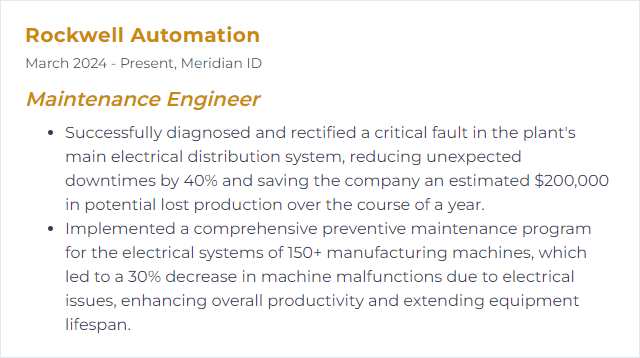
5. Preventive Maintenance
Preventive maintenance is routine care—inspections, lubrication, calibrations—done before failures happen. The goal: longer life, fewer breakdowns, safer operation.
Why It's Important
It turns firefighting into foresight. Lower repair costs, higher uptime, steadier quality—that’s the payback.
How to Improve Preventive Maintenance Skills
Risk-based schedules: prioritize by criticality, consequence, and usage patterns.
Blend strategies: time-based PMs, condition monitoring, and predictive analytics where data allows.
Use a CMMS to plan work, track history, and measure compliance.
Do FMEA on chronic offenders; remove failure modes at the root.
Set KPIs that matter: MTBF, MTTR, schedule compliance, and planned vs. unplanned work.
Right-size spares: min/max levels, lead times, and obsolescence plans.
How to Display Preventive Maintenance Skills on Your Resume
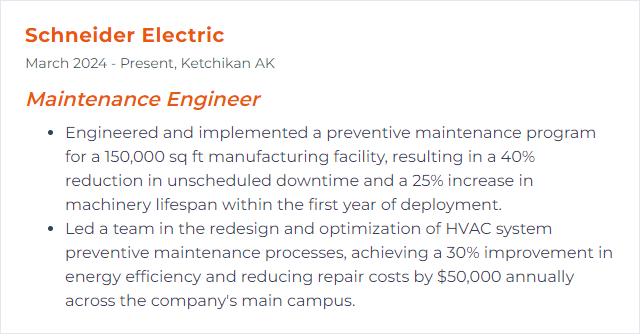
6. Hydraulic Systems
Hydraulics channel pressurized fluid to do serious work. Pumps, valves, actuators, reservoirs—the chain must be clean, tight, and cool for reliable power.
Why It's Important
Compact muscle, precise control. Keep it healthy and heavy machinery behaves with grace instead of grief.
How to Improve Hydraulic Systems Skills
Control contamination: target ISO cleanliness codes, filter aggressively, sample oil, and set alarms.
Inspect hoses and fittings for abrasion, bulges, leaks; replace on condition, not just on failure.
Watch heat: verify cooling capacity, check bypassing, and keep fluid in its ideal temperature band.
Verify pressures and relief settings; confirm actuator speeds and load expectations match design.
Maintain accumulators (precharge checks), case drains, and proper fluid spec and viscosity.
Instrument critical points—pressure, temperature, flow—to spot drift early.
How to Display Hydraulic Systems Skills on Your Resume
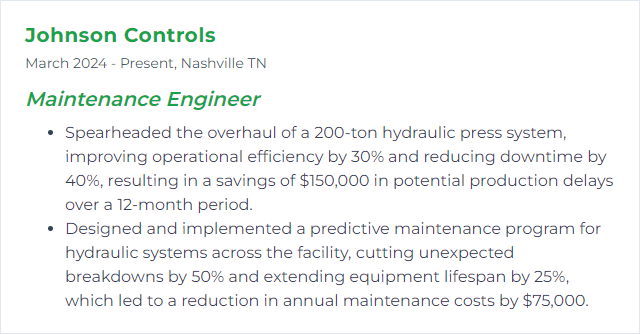
7. Pneumatic Systems
Pneumatics uses compressed air for motion and control. Simple, fast, forgiving—if the air is clean and dry and the leaks are hunted down.
Why It's Important
They’re easy to integrate, safe to maintain, and perfect for quick actuation. Keep energy waste in check and they pay for themselves.
How to Improve Pneumatic Systems Skills
Dry and clean air: dryers, filters, and regular drains; protect valves and actuators from grit and moisture.
Audit for leaks with ultrasonic tools; repair quickly and track savings.
Right-size pressures and flow; over-pressurizing burns money and parts.
Use FRLs near point-of-use; oil only where required and per manufacturer guidance.
Standardize fittings and tubing; label circuits and document setpoints.
Log compressor health: duty cycles, temperature, maintenance intervals, and energy use.
How to Display Pneumatic Systems Skills on Your Resume
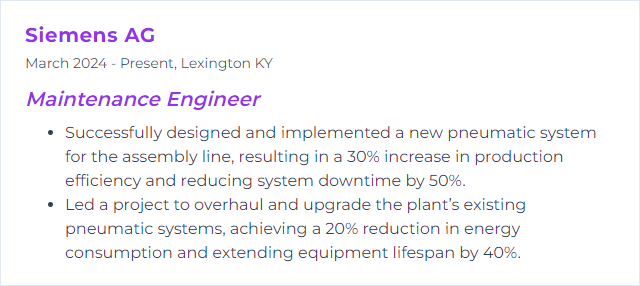
8. Welding Techniques
Welding joins metals—MIG, TIG, stick, and more. In maintenance, it’s about sturdy repairs, clean prep, and procedures that hold up under load and vibration.
Why It's Important
Strong joints stop cracks from spreading and structures from failing. Done right, repairs last; done wrong, they fail when you need them most.
How to Improve Welding Techniques Skills
Know your process window: material ID, filler selection, polarity, gas, preheat, and interpass control.
Follow WPS/PQR guidance; build repeatable setups and avoid guesswork.
Prep like it matters: clean, bevel, fit-up, and tack to control distortion.
Use NDT where needed—visual, dye penetrant, mag particle—to verify integrity.
Protect yourself: PPE, ventilation, fume extraction, and fire watch.
Earn or maintain certifications appropriate to your work scope.
How to Display Welding Techniques Skills on Your Resume
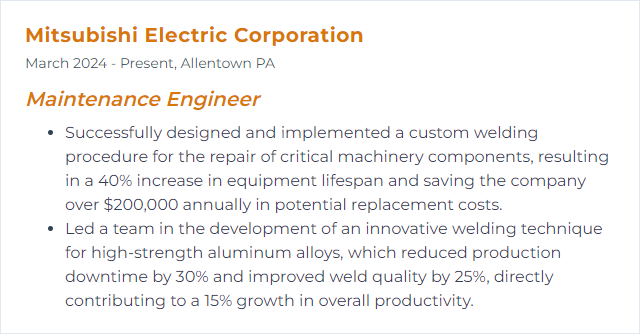
9. SCADA Systems
SCADA platforms watch and steer industrial processes in real time. They gather data, raise alarms, and give operators the controls to act decisively.
Why It's Important
With good SCADA, you see issues forming before a line trips. Better insights, tighter control, fewer unplanned stops.
How to Improve SCADA Systems Skills
Patch and backup on cadence; keep golden images and test restores.
Segment networks, harden endpoints, use MFA for remote access, and follow industrial cybersecurity standards.
Engineer redundancy: servers, communications, and power—failover without drama.
Rationalize alarms (less noise, more signal); timestamp with synchronized clocks.
Build dashboards that answer questions, not just show gauges; trend what drives decisions.
Document changes and maintain configurations under version control.
How to Display SCADA Systems Skills on Your Resume
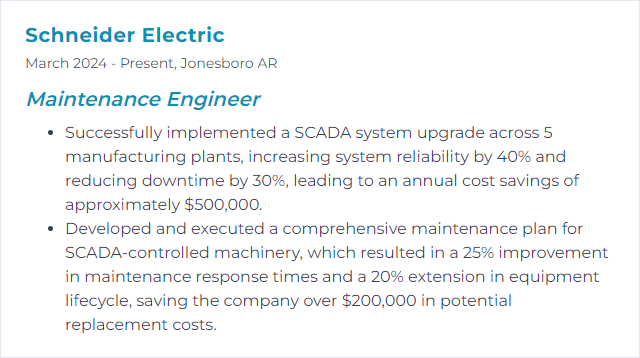
10. Mechanical Design
Mechanical design for maintenance leans into reliability, access, and simplicity. The best designs think about service before the first bolt is tightened.
Why It's Important
Maintainable machines fail less, recover faster, and cost less to own. Thoughtful design pays dividends every shutdown.
How to Improve Mechanical Design Skills
Design for maintainability: tool clearance, lift points, quick-release guards, and clear labeling.
Standardize components and fasteners; reduce part variety and confusion.
Provide condition-monitoring ports and sensor mounts from day one.
Use modular assemblies; swap a module, not the whole machine.
Run simulations and tolerance stacks; verify load paths and thermal effects.
Fight corrosion and dirt: coatings, drains, seals, and smart cable routing.
How to Display Mechanical Design Skills on Your Resume
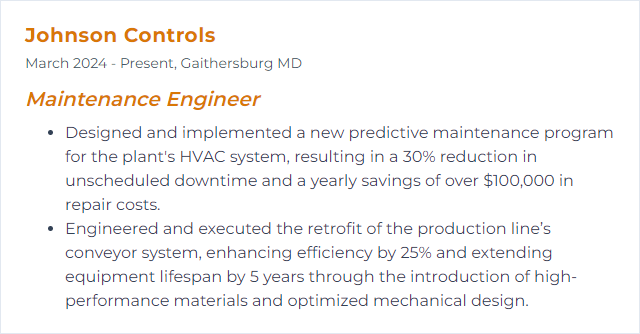
11. Robotics Integration
Robotics integration weaves robots into production—selection, cell design, programming, safety, and handshakes with PLCs, vision, and tooling.
Why It's Important
Done well, robots lift precision and throughput while trimming risk and repetitive strain. Downtime shrinks; consistency rises.
How to Improve Robotics Integration Skills
Learn the stack: robot controllers, safety PLCs, fieldbuses, and cell IO.
Level up programming (e.g., vendor languages, Python/C++), and simulate paths before deployment.
Follow safety standards for industrial and collaborative robots; validate with risk assessments.
Engineer robust EOAT and vision: quick-change, sensible cable management, and good lighting.
Plan maintenance: grease intervals, battery care, calibration, and spare parts on-hand.
Track OEE impacts and iterate—tweak speeds, paths, and error recovery routines.
How to Display Robotics Integration Skills on Your Resume

12. Vibration Analysis
Vibration analysis listens to machines. It turns movement into signals and those signals into insight—bearings, gears, misalignment, imbalance, looseness.
Why It's Important
Early warning is everything. Catch faults at the whisper stage and you won’t hear the bang.
How to Improve Vibration Analysis Skills
Collect good data: correct sensor selection and placement, tight mounting, consistent routes.
Understand spectra: FFT, envelope analysis, order tracking, and time waveform clues.
Build baselines and alarm bands; compare like-for-like operating conditions.
Correlate with other tools—oil analysis, ultrasound, thermography—for a fuller picture.
Document fault frequencies and defect patterns for your common assets.
Trend over time, not just snapshots; the direction of change tells the story.
How to Display Vibration Analysis Skills on Your Resume
